Difference between trumpet and cornet
-
People often ask "what is the difference between a trumpet and a cornet?" One major difference is the proportion of length before and after the valve section, i.e. where in the length of the instrument are the valves. Here is a graphic to illustrate this difference.
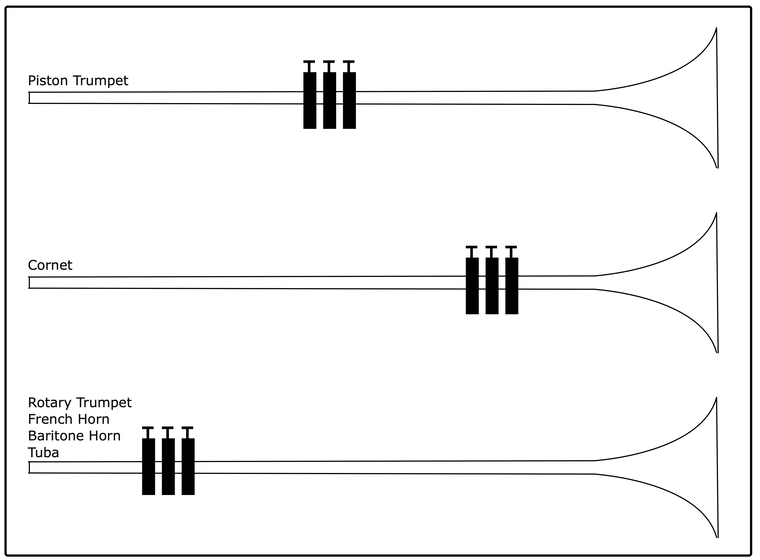
-
Yes! A number of years ago I measured the tubing on my Bach 43 ML trumpet and my Bach 184 L cornet. The ratio of tubing before/after the valve block was approximately 50/50 on the trumpet and 67/33 on the cornet. Plus, the cornet receiver and leadpipe start out smaller than the trumpet ones, so the taper to the valve block is more pronounced. The cornet tuning slide also tapers from ML bore to L bore from one end to the other while the trumpet tuning slide maintains a constant bore throughout.
-
How does the Selmer Balanced Action valve placement effect that? Isn't it's valve placement the same as the cornet in the graphic?
-
@Kehaulani said in Difference between trumpet and cornet:
How does the Selmer Balanced Action valve placement effect that? Isn't it's valve placement the same as the cornet in the graphic?
The Selmer balanced trumpet would lean more toward the 3rd example, with more bell than leadpipe, but not that severe.
-
How is that, when the Selmer valve block is placed further away from the embouchure side of the instrument, as shown in the middle graphic?
Also (and I don't know squat from engineering) but aren't the lengths of conventional trumpet bells the same length.
-
The graphics illustrate the amount of tubing before and after the valve block, not the physical distance (as the crow flies) of the valve block from the mouthpiece and bell flare.
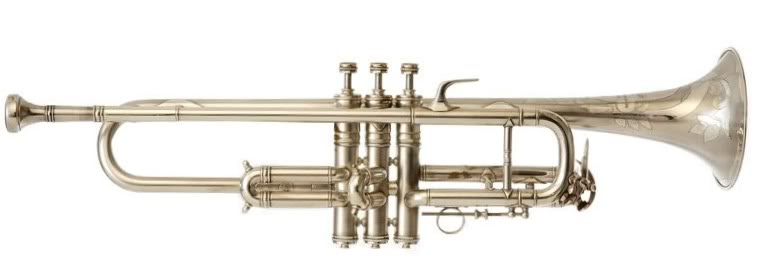
You can see by pushing the valve block forward on the Selmer, the bell tail is much longer than a standard trumpet bell. Also, the tuning slide position is still close to the "standard" distance from the bell flare, but is much closer to the valve block. If you measure the length of the tubing from the receiver to the valve block and the valve block to the end of the bell flare, you'll end up with the 3rd example (but not as drastic) - more tubing after the valve block than before it.
-
The difference in proportions between the Balanced models and others is negligible compared to the difference between, say, piston and rotary trumpets. The Balanced models pretty much follow example 1.
-
It took me a minute. I thought you were talking about the leadpipe to the valve block and obviously that isn't right. Then it dawned on me you are talking about ALL of the tubing before the valve block including the slide on the first valve. Ok... that's somewhat interesting..I guess.

-
Making this a sticky!
-
@Niner Referring to the length of tubing before and after the valve block, not including any valve slides.
-
@Trumpetsplus OK. I'll go back to sleep now.
-
I have expanded on this and posted a blog - http://www.jaegerbrass.com/Blo/Entries/2019/9/difference-between-cornet-and-trumpet.html
Here is the text What is the Difference between a cornet and a trumpet?
When I started playing the cornet in NZ in 1958, the brass band community was vehemently “anti professional”. If anyone was discovered to have been playing for money, in a dance band for instance, they would have their brass band association registration revoked, and would not be allowed to participate in such events as contests. Dance band at that time equalled trumpet, and playing the trumpet was regarded as heresy. Being terrified by these regulations, we young cornetists wondered what the difference actually was between cornets and trumpets. We were told that cornets are tapered and trumpets are cylindrical. This is the commonly accepted view, but, as I have observed, not correct.
Shorter?
The cornet looks to be shorter than the trumpet. It is not. Both instruments play the same pitch indicating that their lengths are the same. Yes the silhouette is shorter but the tubing lengths are identical. The cornet looks shorter because the tubing of a cornet is coiled into two complete turns whereas the trumpet has only one. We refer to this as the wrap. Anyone who has experimented with different shape main slides on their trumpet will have experienced the great effect that these different shapes can make. The cornet has two more half turns than the trumpet.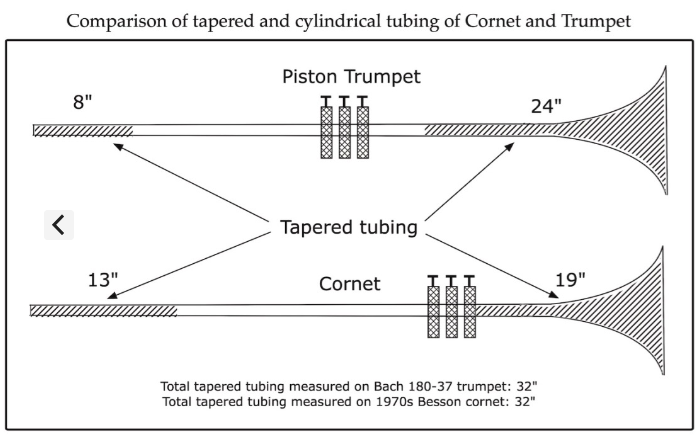
Conical vs Cylindrical?
Many think that the tubing of the cornet is conical whereas the trumpet is cylindrical. This is incorrect. Both instruments have roughly the same proportion of tapered to straight tubing as the accompanying graphic shows. Both the measured instruments have bores starting at around 0.335” at the mouthpiece entry, 0.459” though the valve section, and 4.8” at the bell.The tapers of the lead pipes and bells of both these instruments are the same. I have been told that when French Besson were designing their trumpet they used the same bell mandrel to make the bell as they were using for their cornet. To this day Vincent Bach cornets are offered with #25, #31 or #37 bells which are some of the same bell shapes offered on their trumpets. When 19th century composers were calling for chromatic instruments, these parts went to the cornets because at that time trumpet players were insisting on keeping their valveless “Natural” trumpets. Maybe the straightening of the cornet by one turn to more closely approximate the silhouette of the natural trumpet helped in having these new chromatic trumpets accepted.
Valve Section Placement
The valve section of the cornet is two thirds down the length of the tubing whereas the trumpet valve section is halfway down its length (plus or minus a little bit). This positioning places the valve section (which is where the player holds the instrument) at the center of gravity so that the instrument balances in the hand.Mouthpiece
The mouthpieces for both these instruments are quite different. The cornet, in its British Brass Band mode, requires a relatively deep V shaped cup, whereas the trumpet prefers a shallower bowl shaped cup.
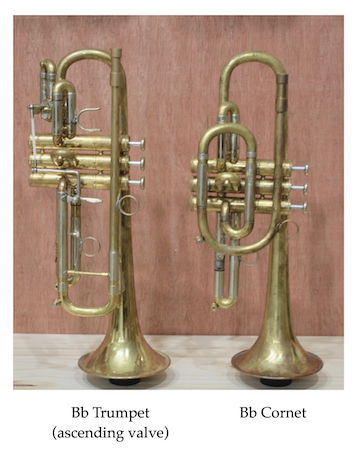
Experiment
I built a cornet which has a receiver for a trumpet mouthpiece. It can be played with either a trumpet mouthpiece or a cornet mouthpiece (when used with an appropriate adapter). When I use a trumpet mouthpiece it sounds and feels like the cornet used in Jazz, and when I play it with a traditional cornet mouthpiece it responds suitably for British Brass Band. It is a cornet not a trumpet.I also built a trumpet with an extra coil in its wrap but with the valves half way down its length, not two thirds down like a cornet. When played with a trumpet mouthpiece it is absolutely trumpet-like; when played with the same cornet piece as above it sounds mellow but does not feel like a cornet. It is a trumpet not a cornet.
Both of these instruments have the valve section at the balance point, the same distance from the player.
Conclusion
It appears that the essential differences between trumpet and cornet are:Mouthpiece shape - bowl cup or V cup
Wrap - one complete turn or two.
Placement of the valves - half way along the tubing or two thirds.
The instrument with a cup mouthpiece, one complete turn, and valves half way along its length can play and feel like a trumpet.
The instrument with a V mouthpiece, two complete turns, and valves two thirds along its length can play and feel like a cornet.
Hopefully this information will help in unraveling the difference between these two instruments.
-
Somehow I saw this string again today and I was looking at the photo of what is labeled a trumpet next to a cornet. The meat of the assertion of differences is in the number of turns in the wrap and length of tubing before and after the valve body. However, in my humble non expert mind my reaction was ....that's not a trumpet no matter the formula rules. That's a long cornet. It was true enough made to sound a bit more like a trumpet than the more circular larger wrap traditional pattern cornet ....but your example is different animal in my mind than a trumpet and solidly in the cornet family.
The wrap in knotlike clusters before the first valve, like what you are calling a trumpet, can be twisted in any direction and connect on the first valve case in about the same location leaving the overall tubing length before the valve case. However, it's still considered by most as a cornet. How about the very popular Conn 80A with the vertical loop with the adjustment wheel before the first case...nobody calls it a trumpet, do they?
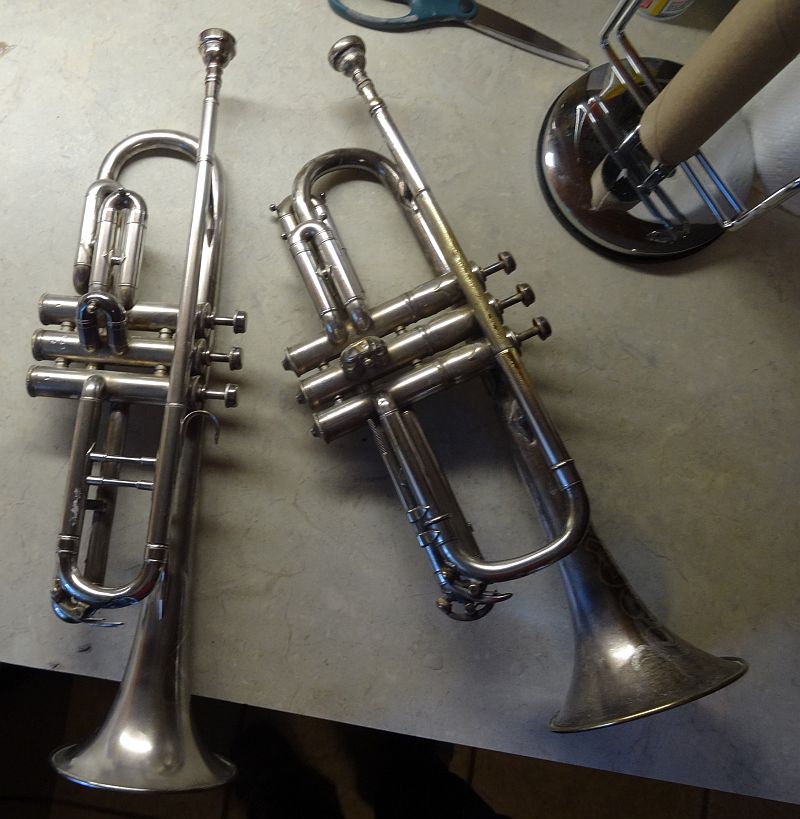
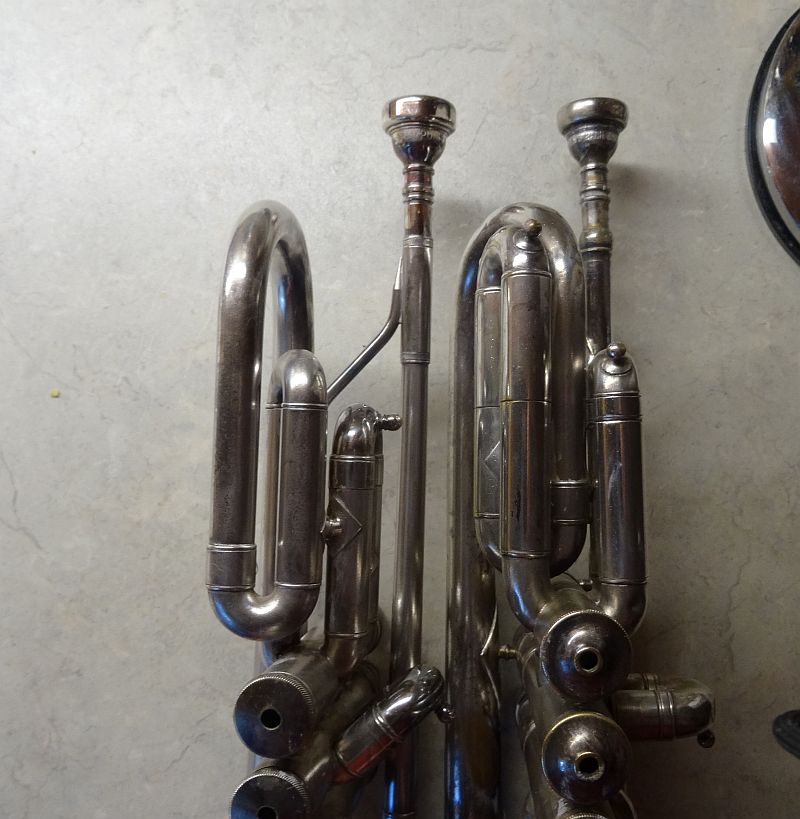
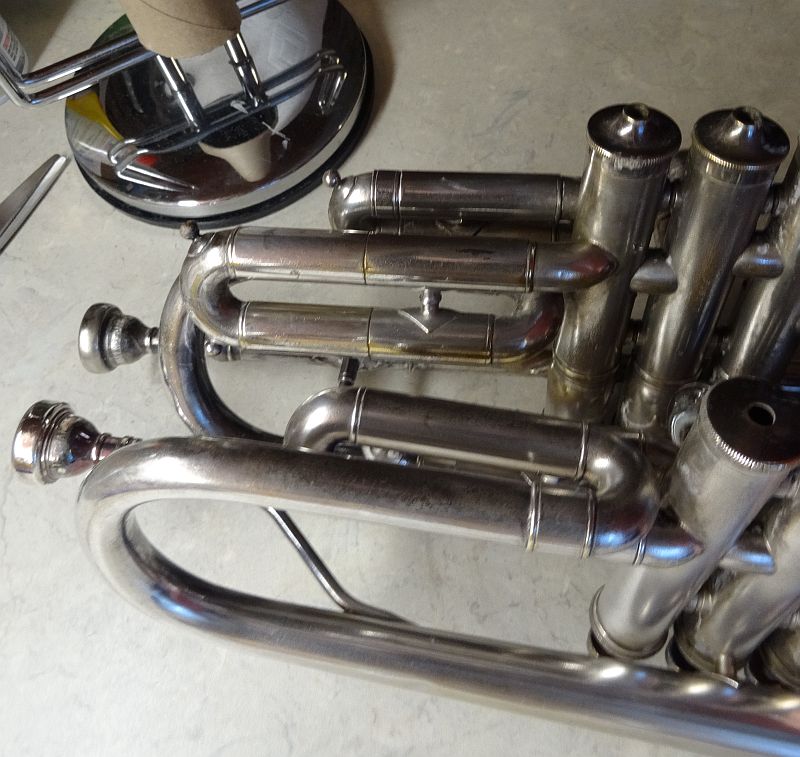
-
@Niner Thanks for your comments. My ascending valve Bb/C trumpet plays, feels, and sounds like a trumpet.
My comments about cornets apply to the "traditional" BBB cornet, and do not necessarily apply to the various "A" series Conns, or similar models from other manufacturers. The acid test I use when I am defining the 2 instruments is:
Is the "Trumpet" an acceptable instrument in all trumpet inclusive ensembles.
Is the "Cornet" an acceptable instrument in serious British Brass Band ensembles. -
@Trumpetsplus I guess we are thinking on different awareness levels. You obviously have a much deeper knowledge about the subject than me..........I recognize your much superior credentials. However, if an instrument may or may not be a cornet based on how one is feeling or on what kind of band or ensemble one is playing in, or where in the world it is, that's all well and good for subjective definition purposes. Certainly fits in with a certain view of things. A subjective view of things can turn a cat into a dog or a dog into a cat easily enough.
-
When comparing the extremes between cornet and trumpet, the differences are obvious, such as comparing a bright trumpet with a lead mouthpiece to a dark cornet with a brass band mouthpiece. The closer those two extremes come together, the less the differences become. Throw the player into the mix, and it can sometimes be difficult to tell the difference in sound.
I've found the Conn 80A "cornet" to be sort of a mid-ground hybrid, neither fish nor fowl. It fits into a lot of playing opportunities, but not into highly specialized extremes.
-
@Niner Perhaps some confusion. It is not "how one is feeling" - that implies good or bad mood, it is "how the instrument feels to the player". And it is not what kind of band or ensemble one is playing that determines what the instrument is, it is what kind of instrument best suits the band or ensemble.
-
@Trumpetsplus I understand different sound quality produced by different brass instruments being chosen based on subtle or not so subtle sound brightness or darkness is what you are focusing on. A cornet that sounds more like a trumpet is a trumpet to you. However, I disagree with ignoring general configuration considerations when classifying instruments by appearance. If the only way you could determine if a house pet is a cat or dog is if you hear them bark or meow then that seems strange to me.
-
@Niner said in Difference between trumpet and cornet:
A subjective view of things can turn a cat into a dog or a dog into a cat easily enough.
-
Aside from the obvious spelling difference and the annoying habit of eBay sending watch list notifications of the same instrument under trumpet and cornet categories, perhaps the differences are the overall length, the number of wraps, and the mouthpiece receiver the manufacturer decided to attach to the small end.